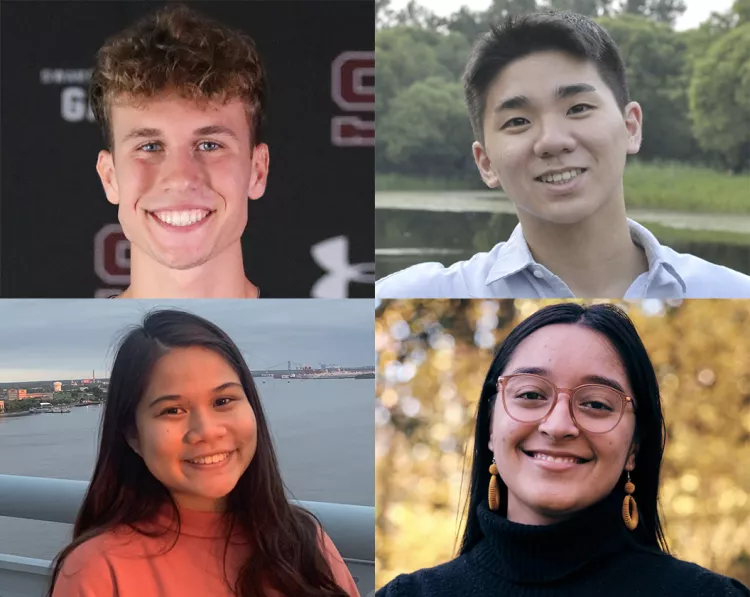Four Swarthmore Students Named Stanford Innovation Fellows

Clockwise from top left: Atticus Hempel ’25, Hojune Kim ’25, Arianna Mosqueda ’25, and Trinh Nguyen ’23.
Four students have been named Stanford University Innovation Fellows (UIF), a selective honor awarded to students who complete an online training program focused on building innovative skills and making change.
Atticus Hempel ’25, Hojune Kim ’25, Arianna Mosqueda ’25, and Trinh Nguyen ’23, received the fellowship this year. With the knowledge gained from their training, the fellows aim to implement projects that will improve the quality of life for students and faculty at the College. Beyond their projects, they serve as change agents and leaders at Swarthmore.
“As an Innovation Fellow, I hope to continue the CIL’s [Center for Innovation and Leadership] goal of empowering students to realize their ideas and creativity through shared resources and knowledge,” says Mosqueda, a film & media studies major from Ruckersville, Va.
“As a first-generation college student, I find that attending an elite institution is overwhelming and exhausting, and the creative ideas I have are often left in the back of my mind and at the bottom of my to-do list,” adds Mosqueda. “Through this fellowship, I want to help foster a feeling of creative empowerment for all students wanting to make a change, including first-generation, low-income students like me.”
This fellowship is run by Stanford's Hasso Plattner Institute of Design. The goal of the fellow program is to equip students — both undergraduate and post-grads — with the skills and knowledge to address global challenges.
“I think this fellowship is a good opportunity to learn more about the design process and, hopefully, better the already impressive Swarthmore community,” says Hempel, a prospective economics, political science, and/or philosophy major from Storrs, Conn. “We've been taking a design thinking course for quite some time now and applying it to what we see at Swarthmore. As a result, I have learned a ton both about the intricacies of Swarthmore's environment and what it means to be a design thinker — it's my goal to use these skills throughout my time at Swarthmore and, of course, my life as well.”
Adds Kim, a prospective engineering major from Busan, South Korea: “I grew up watching engineers build some low-cost apparatus, such as LifeStraw and OneDollarGlasses, that changed the lives of thousands of people. I wanted to become someone like them, and I decided to major in engineering. But ironically, solving real-life problems was nothing like soldering or calculating optimal load: The technology was a tool, not a solution.
“The important skills were knowing how to define a problem, suggest a solution, and test out the solutions,” says Kim, “and I was able to learn them throughout the UIF training sessions by utilizing landscape canvas, design thinking, and lean startup modeling. Both learning and applying these concepts by hand was an extraordinary experience, and I am confident that I will utilize these skill sets in my future projects.”
This year’s cohort of fellows are designing experiences to help all students “learn skills and mindsets necessary to navigate uncertain times and shape the future they want to see,” says Leticia Britos Cavagnaro, co-director of the University Innovation Fellows program.
“They are giving back to their school communities, and at the same time, they’re learning strategies that will help them serve as leaders in their careers after graduation.”



